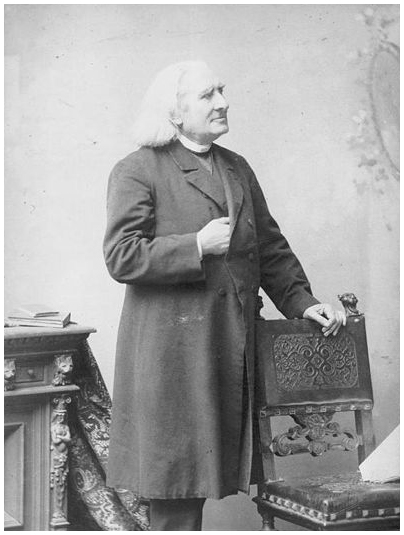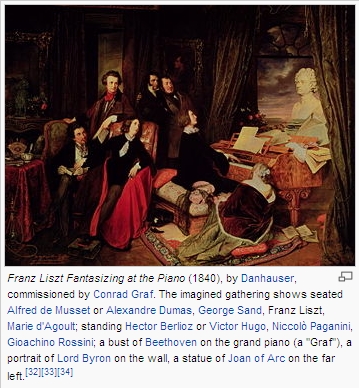LISZT
Liszt became renowned in Europe during the nineteenth century for his virtuosic skill as a pianist. He was said by his contemporaries to have been the most technically advanced pianist of his age. In the 1840s he was considered by some to be perhaps the greatest pianist of all time.[5] He was also a well-known composer, piano teacher, and conductor. He was a benefactor to other composers, including Richard Wagner, Hector Berlioz, Camille Saint-Saëns, Edvard Grieg and Alexander Borodin.[6]
As a composer, Liszt was one of the most prominent representatives of the “Neudeutsche Schule” (“New German School”). He left behind an extensive and diverse body of work in which he influenced his forward-looking contemporaries and anticipated some 20th-century ideas and trends. Some of his most notable contributions were the invention of the symphonic poem, developing the concept of thematic transformation as part of his experiments in musical form and making radical departures in harmony.[7]
Brief introduction
Franz Liszt (German: [fʁant͡s lɪst]);
Hungarian: Liszt Ferencz, in modern use Liszt Ferenc),[1] (October 22, 1811 – July 31, 1886) was a 19th-century Hungarian[2][3][4] composer, pianist, conductor, and teacher.
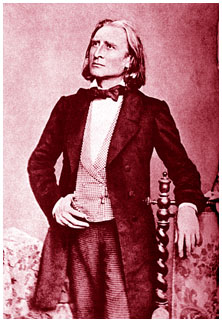
Early life
The earliest known ancestor of Liszt is his great-grandfather, Sebastian List, who was one of the thousands of German migrant serfs locally migrating within the Austrian Empire’s territories (around the area now constituting Lower Austria and Hungary), in the first half of the 18th century, and died in 1793 in Rajka, Moson County, Kingdom of Hungary.[8] Liszt’s grandfather was an overseer on several Esterházy estates; he could play the piano, violin and organ.[9] The Liszt clan dispersed throughout Austria and Hungary and gradually lost touch with one another.[10]
Franz Liszt was born to Marie Anna Lager and Ádám Liszt on October 22, 1811, in the village of Doborján (German: Raiding) in Sopron County, in the Kingdom of Hungary.[note 1] His father would use only the Hungarian language when dealing, as steward, with the folk of the village in which the family settled.[11]
Liszt’s father played the piano, violin, cello, and guitar. He had been in the service of Prince Nikolaus II Esterházy and knew Haydn, Hummel and Beethoven personally. At age six, Franz began listening attentively to his father’s piano playing and showed an interest in both sacred and Romani music. Adam began teaching him the piano at age seven, and Franz began composing in an elementary manner when he was eight. He appeared in concerts at Sopron and Pozsony (German: Pressburg; Slovak: Bratislava) in October and November 1820 at age 9. After the concerts, a group of wealthy sponsors offered to finance Franz’s musical education abroad.
In Vienna, Liszt received piano lessons from Carl Czerny, who in his own youth had been a student of Beethoven and Hummel. He also received lessons in composition from Antonio Salieri, who was then music director of the Viennese court. His public debut in Vienna on December 1, 1822, at a concert at the “Landständischer Saal,” was a great success. He was greeted in Austrian and Hungarian aristocratic circles and also met Beethoven and Schubert.[12] In spring 1823, when the one year leave of absence came to an end, Adam Liszt asked Prince Esterházy in vain for two more years. Adam Liszt therefore took his leave of the Prince’s services. At the end of April 1823, the family returned to Hungary for the last time. At end of May 1823, the family went to Vienna again.
Towards the end of 1823 or early 1824, Liszt’s first published composition appeared in print, a Variation on a Waltz by Diabelli (now S. 147), which was Variation 24 in Part II of Vaterländischer Künstlerverein. This anthology, commissioned by Diabelli, included 50 variations on his waltz by 50 different composers (Part II), Part I being taken up by Beethoven’s 33 variations on the same theme, which are now better known as the Diabelli Variations, Op. 120.
Paganini

After attending an April 20, 1832 concert for charity, for the victims of a Parisian cholera epidemic, by Niccolò Paganini,[16] Liszt became determined to become as great a virtuoso on the piano as Paganini was on the violin. Paris in the 1830s had become the nexus for pianistic activities, with dozens of pianists dedicated to perfection at the keyboard. Some, such as Sigismond Thalberg and Alexander Dreyschock, focused on specific aspects of technique (e.g. the “three-hand effect” and octaves, respectively). While it was called the “flying trapeze” school of piano playing, this generation also solved some of the most intractable problems of piano technique, raising the general level of performance to previously unimagined heights. Liszt’s strength and ability to stand out in this company was in mastering all the aspects of piano technique cultivated singly and assiduously by his rivals.[17]
In 1833 he made transcriptions of several works by Berlioz, including the Symphonie fantastique. His chief motive in doing so, especially with the Symphonie, was to help the poverty-stricken Berlioz, whose symphony remained unknown and unpublished. Liszt bore the expense of publishing the transcription himself and played it many times to help popularise the original score.[18] He was also forming a friendship with a third composer who influenced him, Frédéric Chopin; under his influence Liszt’s poetic and romantic side began to develop.[13]
n 1833, Liszt began his relationship with the Countess Marie d’Agoult. In addition to this, at the end of April 1834 he made the acquaintance of Felicité de Lamennais. Under the influence of both, Liszt’s creative output exploded. In 1834 Liszt debuted as a mature and original composer with his piano compositions Harmonies poétiques et religieuses and the set of three Apparitions. These were all poetic works which contrasted strongly with the fantasies he had written earlier.[19]
In 1835 the countess left her husband and family to join Liszt in Geneva; their daughter Blandine was born there on December 18. Liszt taught at the newly founded Geneva Conservatory, wrote a manual of piano technique (later lost)[20] and contributed essays for the Paris Revue et gazette musicale. In these essays, he argued for the raising of the artist from the status of a servant to a respected member of the community.[13]
For the next four years Liszt and the countess lived together, mainly in Switzerland and Italy, where their daughter, Cosima, was born in Como, with occasional visits to Paris. On May 9, 1839 Liszt’s and the countess’s only son, Daniel, was born, but that autumn relations between them became strained. Liszt heard that plans for a Beethoven monument in Bonn were in danger of collapse for lack of funds, and pledged his support. Doing so meant returning to the life of a touring virtuoso. The countess returned to Paris with the children, while Liszt gave six concerts in Vienna, then toured Hungary.[13]
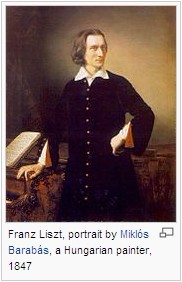
Touring Europe
or the next eight years Liszt continued to tour Europe, spending holidays with the countess and their children on the island of Nonnenwerth on the Rhine in summers 1841 and 1843. In spring 1844 the couple finally separated. This was Liszt’s most brilliant period as a concert pianist. Honours were showered on him and he was adulated everywhere he went.[13] Since Liszt often appeared three or four times a week in concert, it could be safe to assume that he appeared in public well over a thousand times during this eight-year period. Moreover, his great fame as a pianist, which he would continue to enjoy long after he had officially retired from the concert stage, was based mainly on his accomplishments during this time.[21]
After 1842 “Lisztomania” swept across Europe. The reception Liszt enjoyed as a result can only be described as hysterical. Women fought over his silk handkerchiefs and velvet gloves, which they ripped to shreds as souvenirs. Helping fuel this atmosphere was the artist’s mesmeric personality and stage presence. Many witnesses later testified that Liszt’s playing raised the mood of audiences to a level of mystical ecstasy.[22]
Adding to his reputation was the fact that Liszt gave away much of his proceeds to charity and humanitarian causes. In fact, Liszt had made so much money by his mid-forties that virtually all his performing fees after 1857 went to charity. While his work for the Beethoven monument and the Hungarian National School of Music are well known, he also gave generously to the building fund of Cologne Cathedral, the establishment of a Gymnasium at Dortmund, and the construction of the Leopold Church in Pest. There were also private donations to hospitals, schools and charitable organizations such as the Leipzig Musicians Pension Fund. When he found out about the Great Fire of Hamburg, which raged for three weeks during May 1842 and destroyed much of the city, he gave concerts in aid of the thousands of homeless there.[23]
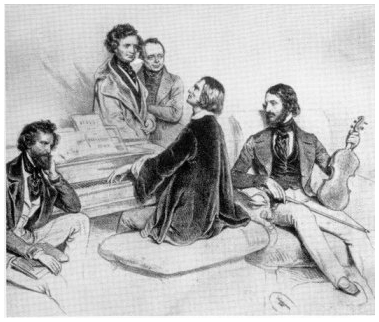
Liszt in Weimar
In February 1847, Liszt played in Kiev. There he met the Princess Carolyne zu Sayn-Wittgenstein, who dominated most of the rest of his life. She persuaded him to concentrate on composition, which meant giving up his career as a travelling virtuoso. After a tour of the Balkans, Turkey and Russia that summer, Liszt gave his final concert for pay at Elisavetgrad in September. He spent the winter with the princess at her estate in Woronince.[24] By retiring from the concert platform at 35, while still at the height of his powers, Liszt succeeded in keeping the legend of his playing untarnished.[25]
The following year, Liszt took up a long-standing invitation of Grand Duchess Maria Pavlovna of Russia to settle at Weimar, where he had been appointed Kapellmeister Extraordinaire in 1842, remaining there until 1861. During this period he acted as conductor at court concerts and on special occasions at the theatre. He gave lessons to a number of pianists, including the great virtuoso Hans von Bülow, who married Liszt’s daughter Cosima in 1857 (years later, she would marry Richard Wagner). He also wrote articles championing Berlioz and Wagner. Finally, Liszt had ample time to compose and during the next 12 years revised or produced those orchestral and choral pieces upon which his reputation as a composer mainly rests. His efforts on behalf of Wagner, who was then an exile in Switzerland, culminated in the first performance of Lohengrin in 1850.
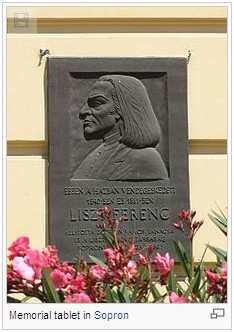
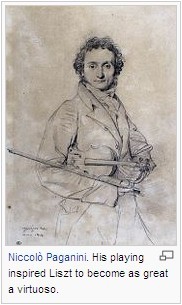
Princess Carolyne lived with Liszt during his years in Weimar. She eventually wished to marry Liszt, but since she had been previously married and her husband, Russian military officer Prince Nikolaus zu Sayn-Wittgenstein-Ludwigsburg (1812–1864), was still alive, she had to convince the Roman Catholic authorities that her marriage to him had been invalid. After huge efforts and a monstrously intricate process, she was temporarily successful (September 1860). It was planned that the couple would marry in Rome, on October 22, 1861, Liszt’s 50th birthday. Liszt having arrived in Rome on October 21, 1861, the Princess nevertheless declined, by the late evening, to marry him. It appears that both her husband and the Tsar of Russia had managed to quash permission for the marriage at the Vatican. The Russian government also impounded her several estates in the Polish Ukraine, which made her later marriage to anybody unfeasible.
Liszt in Rome
The 1860s were a period of great sadness in Liszt’s private life. On December 13, 1859, he lost his son Daniel, and on September 11, 1862, his daughter Blandine also died. In letters to friends, Liszt afterwards announced that he would retreat to a solitary living. He found it at the monastery Madonna del Rosario, just outside Rome, where on June 20, 1863, he took up quarters in a small, Spartan apartment. He had on June 23, 1857, already joined a Franciscan order.[26]
On April 25, 1865, he received the tonsure at the hands of Cardinal Hohenlohe. Following this he was sometimes called the Abbé Liszt. On July 31, 1865 he received the four minor orders of porter, lector, exorcist, and acolyte. On August 14, 1879 he was made an honorary canon of Albano.[27]
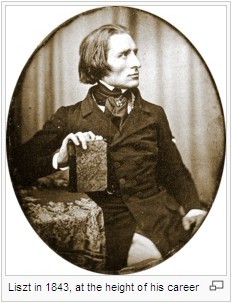
On some occasions, Liszt took part in Rome’s musical life. On March 26, 1863, at a concert at the Palazzo Altieri, he directed a programme of sacred music. The “Seligkeiten” of his “Christus-Oratorio” and his “Cantico del Sol di Francesco d’Assisi”, as well as Haydn’s “Die Schöpfung” and works by J. S. Bach, Beethoven, Jommelli, Mendelssohn and Palestrina were performed. On January 4, 1866, Liszt directed the “Stabat mater” of his “Christus-Oratorio”, and on February 26, 1866, his “Dante Symphony”. There were several further occasions of similar kind, but in comparison with the duration of Liszt’s stay in Rome, they were exceptions. Bódog Pichler, who visited Liszt in 1864 and asked him for his future plans, had the impression that Rome’s musical life was not satisfying for Liszt.
Threefold life
Liszt was invited back to Weimar in 1869 to give master classes in piano playing. Two years later he was asked to do the same in Budapest at the Hungarian Music Academy. From then until the end of his life he made regular journeys between Rome, Weimar and Budapest, continuing what he called his “vie trifurquée” or threefold existence. It is estimated that Liszt travelled at least 4,000 miles a year during this period in his life—an exceptional figure given his advancing age and the rigors of road and rail in the 1870s.[28]
Last years
Liszt fell down the stairs of the Hotel in Weimar on July 2, 1881. Though friends and colleagues had noted swelling in his feet and legs when he had arrived in Weimar the previous month (an indication of possible congestive heart failure), he had been in good health upto that point and was still fit and active. He was left immobilized for eight weeks after the accident and never fully recovered from it. A number of ailments manifested—dropsy, asthma, insomnia, a cataract of the left eye and heart disease. The last-mentioned eventually contributed to Liszt’s death. He became increasingly plagued by feelings of desolation, despair and preoccupation with death—feelings which he expressed in his works from this period. As he told Lina Ramann, “I carry a deep sadness of the heart which must now and then break out in sound.”[29]
He died in Bayreuth, Germany, on July 31, 1886, at age 74, officially as a result of pneumonia which he may have contracted during the Bayreuth Festival hosted by his daughter Cosima. Questions have been posed as to whether medical malpractice played a direct part in Liszt’s demise.[30]
Composer Camille Saint-Saëns, an old friend, whom Liszt had once called “the greatest organist in the world”, dedicated his Symphony No. 3 “Organ Symphony” to Liszt; it had premiered in London only a few weeks before his death.
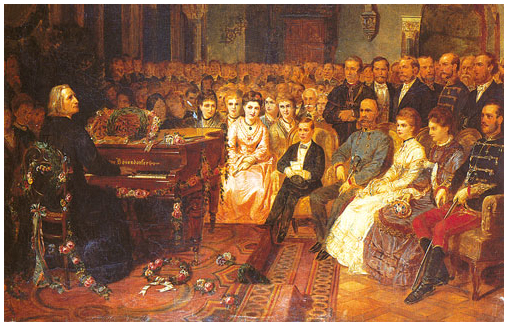

SectionsLiszt as pianist
Performing style
There are few, if any, good sources that give an impression of how Liszt really sounded from the 1820s. Carl Czerny claimed Liszt was a natural who played according to feeling, and reviews of his concerts especially praise the brilliance, strength and precision in his playing. At least one also mentions his ability to keep absolute tempo,[31] which may be due to his father’s insistence that he practice with a metronome.[citation needed] His repertoire at this time consisted primarily of pieces in the style of the brilliant Viennese school, such as concertos by Hummel and works by his former teacher Czerny, and his concerts often included a chance for the boy to display his prowess in improvisation.
Franz Liszt Fantasizing at the Piano (1840), by Danhauser, commissioned by Conrad Graf. The imagined gathering shows seated Alfred de Musset or Alexandre Dumas, George Sand, Franz Liszt, Marie d’Agoult; standing Hector Berlioz or Victor Hugo, Niccolò Paganini, Gioachino Rossini; a bust of Beethoven on the grand piano (a “Graf”), a portrait of Lord Byron on the wall, a statue of Joan of Arc on the far left.[32][33][34]Following the death of Liszt’s father in 1827 and his hiatus from the life as a touring virtuoso, it is likely Liszt’s playing gradually developed a more personal style. One of the most detailed descriptions of his playing from this time comes from the winter of 1831/1832, during which he was earning a living primarily as a teacher in Paris. Among his pupils were Valerie Boissier, whose mother Caroline kept a careful diary of the lessons. From her we learn that:
“M. Liszt’s playing contains abandonment, a liberated feeling, but even when it becomes impetuous and energetic in his fortissimo, it is still without harshness and dryness. […] [He] draws from the piano tones that are purer, mellower and stronger than anyone has been able to do; his touch has an indescribable charm. […] He is the enemy of affected, stilted, contorted expressions. Most of all, he wants truth in musical sentiment, and so he makes a psychological study of his emotions to convey them as they are. Thus, a strong expression is often followed by a sense of fatigue and dejection, a kind of coldness, because this is the way nature works.”
Possibly influenced by Paganini’s showmanship, once Liszt began focusing on his career as a pianist again his emotionally vivid presentations of the music were rarely limited to mere sound. His facial expression and gestures at the piano would reflect what he played, for which he was sometimes mocked in the press.[35] Also noted was the extravagant liberties he could take with the text of a score at this time. Berlioz tells us how Liszt would add cadenzas, tremolos and trills when playing the first movement of Beethoven’s Moonlight Sonata, and created a dramatic scene by changing the tempo between Largo and Presto.[36] In his Baccalaureus letter to George Sand from the beginning of 1837, Liszt admitted that he had done so for the purpose of gaining applause, and promised to follow both the letter and the spirit of a score from then on. It has been debated to what extent he realized his promise, however. By July 1840 the British newspaper The Times could still report
“His performance commenced with Händel’s Fugue in E minor, which was played by Liszt with an avoidance of everything approaching to meretricious ornament, and indeed scarcely any additions, except a multitude of ingeniously contrived and appropriate harmonies, casting a glow of colour over the beauties of the composition, and infusing into it a spirit which from no other hand it ever received.”
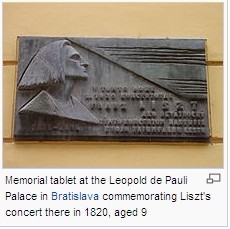
Repertoire
During his years as a travelling virtuoso Liszt performed an enormous amount of music throughout Europe,[37] but his core repertoire always centered around his own compositions, paraphrases and transcriptions. Studying Liszt’s German concerts between 1840 and 1845, the five most frequently played pieces were the Grand galop chromatique, Schubert’s Erlkönig (in Liszt’s transcription), Réminiscences de Don Juan, Réminiscences de Robert le Diable, and Réminiscences de Lucia de Lammermoor.[38] Among the works by other composers we find compositions like Weber’s Invitation to the Dance, Chopin mazurkas, études by composers like Ignaz Moscheles, Chopin and Ferdinand Hiller, but also major works by Beethoven, Schumann, Weber and Hummel, and from time to time even selections from Bach, Handel and Scarlatti.
Most of the concerts at this time were shared with other artists, and as a result Liszt also often accompanied singers, participated in chamber music, or performed works with an orchestra in addition to his own solo part. Frequently played works include Weber’s Konzertstück, Beethoven’s Emperor Concerto and Choral Fantasy, and Liszt’s reworking of the Hexameron for piano and orchestra. His chamber music repertoire included Hummel’s Septet, Beethoven’s Archduke Trio and Kreutzer Sonata, and a large selection of songs by composers like Rossini, Donizetti, Beethoven and especially Schubert. At some concerts Liszt could not find musicians to share the program with, and consequently was among the first to give solo piano recitals in the modern sense of the word. The term was coined by the publisher Frederick Beale, who suggested it for Liszt’s concert at the Hanover Square Rooms in London on June 9, 1840,[39] even though Liszt had given concerts all by himself already by March 1839.[40]


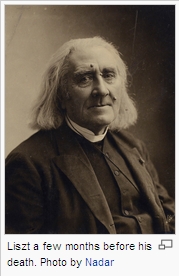
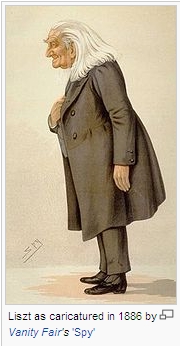
Musical works
Liszt was a prolific composer. His composition career has a clear arch that follows his changing professional and personal life.[citation needed] Liszt is best known for his piano music, but he wrote extensively for many media. Because of his background as a forefront technical piano virtuoso, Liszt’s piano works are often marked by their difficulty. Liszt is very well known as a programmatic composer, or an individual who bases his compositional ideas in extra-musical things such as a poetry or painting. Liszt is credited with the creation of the Symphonic Poem which is a programmatic orchestral work that generally consists of a single movement.
Liszt’s compositional style delved deeply into issues of unity both within and across movements. For this reason, in his most famous and virtuosic works, he is an archetypal Romantic composer. Liszt pioneered the technique of thematic transformation, a method of development which was related to both the existing variation technique and to the new use of the Leitmotif by Richard Wagner.
Piano music
The largest and best-known portion of Liszt’s music is his original piano work. His thoroughly revised masterwork, “Années de pèlerinage” (“Years of Pilgrimage”) includes arguably his most provocative and stirring pieces. This set of three suites ranges from the virtuosity of the Suisse Orage (Storm) to the subtle and imaginative visualizations of artworks by Michelangelo and Raphael in the second set. Années contains some pieces which are loose transcriptions of Liszt’s own earlier compositions; the first “year” recreates his early pieces of “Album d’un voyageur”, while the second book includes a resetting of his own song transcriptions once separately published as “Tre sonetti di Petrarca” (“Three sonnets of Petrarch”). The relative obscurity of the vast majority of his works may be explained by the immense number of pieces he composed, and the level of technical difficulty which was present in much of his composition.
Liszt’s piano works are usually divided into two categories. On the one hand, there are “original works”, and on the other hand “transcriptions”, “paraphrases” or “fantasies” on works by other composers. Examples for the first category are works such as the piece Harmonies poétiques et religieuses of May 1833 and the Piano Sonata in B minor (1853). Liszt’s transcriptions of Schubert songs, his fantasies on operatic melodies, and his piano arrangements of symphonies by Berlioz and Beethoven are examples from the second category. As special case, Liszt also made piano arrangements of his own instrumental and vocal works. Examples of this kind are the arrangement of the second movement “Gretchen” of his Faust Symphony and the first “Mephisto Waltz” as well as the “Liebesträume No. 3” and the two volumes of his “Buch der Lieder”
Transcriptions
When Liszt wrote transcriptions of works by other composers, he invested a lot of creativity in doing so. Instead of just overtaking original melodies and harmonies, he ameliorated them. In the case of his fantasies and transcriptions in the Italian style, composers such as Bellini and Donizetti knew that certain forms, usually periods of eight measures, were to be filled with music. Occasionally, while the first half of a period was composed with inspiration, the second half was added with mechanical routine. Liszt changed this by modifying the melody, bass and occasionally the harmonies.
Liszt’s transcriptions yielded results that were often more inventive than what Liszt or the original composer could have achieved alone. Some notable examples are the Sonnambula-fantasy (Bellini), the Rigoletto-Paraphrase (Verdi), the Faust-Walzer (Gounod), and “Réminiscences de Don Juan” (Mozart). Hans von Bülow admitted that Liszt’s transcription of his Dante Sonett “Tanto gentile” was much more refined than the original he himself had composed.[41] Liszt’s transcriptions of Schubert songs, his fantasies on operatic melodies, and his piano arrangements of symphonies by Berlioz and Beethoven are other well known examples of piano transcriptions.[citation needed]
Liszt was the second pianist (after Kalkbrenner) to transcribe Beethoven’s symphonies for the piano. He usually performed them for audiences that would probably never have an opportunity to hear the orchestral version.
Original songs
Franz Liszt composed about six dozen original songs with piano accompaniment. In most cases the lyrics were in German or French, but there are also some songs in Italian and Hungarian and one song in English. Liszt began with the song “Angiolin dal biondo crin” in 1839, and by 1844 had composed about two dozen songs. Some of them had been published as single pieces. In addition, there was an 1843–1844 series “Buch der Lieder”. The series had been projected for three volumes, consisting of six songs each, but only two volumes appeared.
Although Liszt’s early songs are seldom sung, they show him in much better light than works such as the paraphrase “Gaudeamus igitur” and the Galop after Bulhakow, both composed in 1843. The transcriptions of the two volumes of the “Buch der Lieder” can be counted among Liszt’s finest piano works.[42] However, the contemporaries had much to criticise with regard to the style of the songs. Further critical remarks can be found in Peter Raabe’s Liszts Schaffen.
Today, Liszt’s songs are nearly entirely forgotten. As an exception, most frequently the song “Ich möchte hingehen” is cited. It is because of a single bar, most resembling the opening motif of Wagner’s Tristan und Isolde. While it is commonly claimed that Liszt wrote that motif ten years before Wagner started work on his masterpiece,[43] it has turned out that this is not true: the original version of “Ich möchte hingehn” was composed in 1844 or 1845. There are four manuscripts, and only a single one, a copy by August Conradi, contains the said bar with the Tristan motif. It is on a paste-over in Liszt’s hand. Since in the second half of 1858 Liszt was preparing his songs for publication, and he just at that time received the first act of Wagner’s Tristan, it is most likely that the version on the paste-over was a quotation from Wagner.[44] This is not to say, the motif was originally invented by Wagner. An earlier example can be found in bar 100 of Liszt’s Ballade No. 2 in B minor for piano, composed in 1853.[45]
Programme music
Liszt, in some of his works, supported the idea of programme music – that is, music intended to evoke extra-musical ideas. By contrast, absolute music (a radical new idea in the 19th century world of music) stands for itself and is intended to be appreciated without any particular reference to the outside world.
Liszt’s own point of view regarding programme music can for the time of his youth be taken from the preface of the Album d’un voyageur (1837). According to this, a landscape could evoke a certain kind of mood. Since a piece of music could also evoke a mood, a mysterious resemblance with the landscape could be imagined. In this sense the music would not paint the landscape, but it would match the landscape in a third category, the mood.
In July 1854 Liszt wrote his essay about Berlioz and Harold in Italy that stated that not all music was programme music. If, in the heat of a debate, a person would go so far as to claim the contrary, it would be better to put all ideas of programme music aside. But it would be possible to take means like harmony, modulation, rhythm, instrumentation and others to let a musical motif endure a fate. In any case, a programme should only be added to a piece of music if it was necessarily needed for an adequate understanding of that piece.
Still later, in a letter to Marie d’Agoult of November 15, 1864, Liszt wrote:
“Without any reserve I completely subscribe to the rule of which you so kindly want to remind me, that those musical works which are in a general sense following a programme must take effect on imagination and emotion, independent of any programme. In other words: All beautiful music must be first rate and always satisfy the absolute rules of music which are not to be violated or prescribed”.[46]
